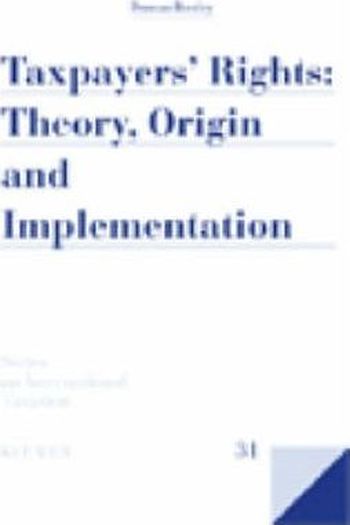
No government can be sustained without the ability to tax its citizens. Democratic societies typically guarantee, in varying forms and degrees, a basic set of taxpayer rights. These rights are essential in establishing an effective and reasonable taxation process. Author Duncan Bentleyand#8217;s work argues that it is timely and beneficial to articulate a Model of taxpayersand#8217; rights as a guide to best practice in tax administration. It first finds a rationale for a Model in legal and rights theory and concludes that a Model is necessary, timely and a realistic option in the context of current developments in tax administration. Next, it articulates the principles that should underlie any Model. These are drawn from traditional analysis of tax systems and refined to provide a standard approach and interpretation. It is noted that the content of any Model will be determined in part by the approach taken to its interpretation. A classification of taxpayersand#8217; rights in the context of the type of enforcement underlying the rights provides the basis for a detailed analysis of enforcement mechanisms. The analysis is conducted in the light of recent developments in the application of constitutional law and alternative dispute resolution theory. The lionand#8217;s share of this work comprises a detailed analysis and articulation of the primary and secondary legal and administrative rights that should be available to taxpayers in conjunction with a comprehensive framework of principles of good governance and good practice. A wide-ranging comparative analysis and synthesis of the substantial available literature in both law and other disciplines provides support for the articulation of a Model of taxpayersand#8217; rights. The Model is appropriate for use as a guide to best practice in tax administration. Professor Bentleyand#8217;s book effectively tackles a host of important issues.
The theory and framework of taxpayersand#8217; rights to provide support and reassurance for particular approaches to tax administration design; the updated principles for analysis of any tax system; the classification of taxpayersand#8217; rights so that they can understand why much tax administration and procedure operates in the way it does; the design of legislative mechanisms to assist in the design and drafting of tax administration; the design and implementation of dispute resolution systems in tax administration; specific detail on the powers and duties of tax administrators and how they should be exercised; the design and implementation of taxpayersand#8217; charters and other guidelines on taxpayersand#8217; rights; specific detail on the rules and procedures in tax administration, relating in any way to taxpayersand#8217; rights, and how they should be applied; and a clear and articulated standard of best practice in tax administration and governance for quality assurance purposes.
In sum, this work will address a number of important issues faced by international tax professionals - including government officials, academics, and practitioners - in a way that is both instructive and constructive.